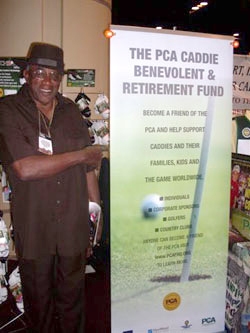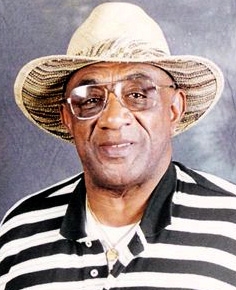Blog: June-August 2012
“The Looper Line”
A view into the life of a legendary golf caddie
June 1, 2012
Hello, Friends of Caddies and the game.
I’m honored to help reach golfers and friends and “Thank You,” Debert Cook, for the opportunity. I look forward to bringing all of you monthly insights on the Tour and in Life.
I hope to attend your events and that of AAGD to help charities worldwide. Want me to come see you? Just reach me at my contact information below.
 I have now moved to the St. Augustine area. Here there are some of the oldest churches in the USA. St. Augustine is a great old city and located here is The World Golf Hall of Fame. I plan to be working near the great golf course Ocean Hammock with is run by Sheila C. Johnson and her number one Salamander Hospitality Team. Please join me for some great stories, photos and a great round of golf to help the kids and the game.
I have now moved to the St. Augustine area. Here there are some of the oldest churches in the USA. St. Augustine is a great old city and located here is The World Golf Hall of Fame. I plan to be working near the great golf course Ocean Hammock with is run by Sheila C. Johnson and her number one Salamander Hospitality Team. Please join me for some great stories, photos and a great round of golf to help the kids and the game.
With my friend Jack Ross, we will be looking inside the ropes for stories and insights of the last traveling caddies from the fifties to see want we can do to lower your score, have more FUN and help you manage yourself around the course by learning golf through the eyes of a caddie.
I meet Jack In January 2011 at the PGA Show after he attended a USGA Member Education program at Arnold Palmer’s Bay Hill Club, lured by the chance to play the championship course, glean some knowledge about golf rules and the inner workings of the USGA, but above all he met The King himself.
Here is his story how we came together (as told by Jack): At the time I was a novice sports writer interested in expanding my golf horizons, and at the last minute was coaxed by a colleague into attending the PGA Merchandise Show in Orlando, which just happened to start the week following the Bay Hill event. I knew nothing about the merchandise show, but had some time on my hands and figured what could be wrong with spending some more time in Florida during one of the worst winters in New England history.
 It’s funny how random events can alter one’s life.
It’s funny how random events can alter one’s life.
Connections I made at the PGA Merchandise Show in Orlando, Florida proved pivotal to the development of my golf writing, and, more importantly, brought some special people into my life.
One of those people is Alfred “Rabbit” Dyer, who looped for Gary Player for many years. I was introduced to Rabbit at the Professional Caddies Association (PCA) booth by President, Dennis Cone on the exhibition floor featuring a state-of-the-art fishing boat at their booth. (It was not immediately clear to me how the fishing boat fit into the PCA mission, but I later learned that Dennis was promoting a “Blast & Cast” program to allow children with debilitating Illnesses to fish and smile for a while with PGA Tour & Fishing professionals.) See Info Here
I was struck by Dennis’ enthusiasm for promoting caddies, his energetic and optimistic demeanor, and by his genuine interest in my budding golf writing career. I was flattered when, after only a short conversation, he invited me to be a part of the project to produce the PCA’s second book, “
Mastering Golf’s Toughest Shots.”
Rabbit, who was named the Caddie Hall of Fame Ambassador to the PCA in 2000, was at the show to help Dennis promote the PCA mission of supporting caddying both in the United States and internationally. He was a hard person to miss, with his towering frame, broad smile, and a distinctive broad-brimmed hat. Rabbit radiated both warmth and a calm resoluteness, character traits which surely served him well in his long career of caddying for some of the best golf professionals.
 In his foreword to “Mastering Golf’s Toughest Shots,” Gary Player praised Rabbit as a friend, “special” man, and a meaningful part of his success, and described the various roles that caddies play:
In his foreword to “Mastering Golf’s Toughest Shots,” Gary Player praised Rabbit as a friend, “special” man, and a meaningful part of his success, and described the various roles that caddies play:
“The image of a caddie that you see on TV is of someone lugging a huge bag around the course, tending the pin, and reading putts, but that is not the real role that a caddie plays. Caddies are an important part of a professional’s success because if you have a good caddie, he or she can help you develop and execute a strategic plan that helps you win. They are part friend, part adviser. They are part cheerleader and part psychologist.”
When we arrived at a tournament, Rabbit would walk the course during the practice rounds and really pay attention to the setup and, most important, how the greens were playing. We would discuss each hole and develop a strategy that made sense for my game. … Most certainly, I know one thing for sure: I could not have done it without him.
Rabbit’s preface to “Mastering Golf’s Toughest Shots” conveys his passion for caddying and highlights the important contributions caddies have made to the game of golf as well as the enduring values and life skills that can be gained through looping:
“I have been blessed to be a caddie! I started at the age of nine as a ball boy at Metairie Country Club in New Orleans in 1946. Ten years later, I was a caddie working for Gary Player on the PGA Tour and I thank him. Life was different back then.”
“Caddies took Greyhound buses to tournaments, slept four to a room or at the ‘Underwood Hotel’ in the local town. We were a band of guys who showed up, shut up, and stayed up each week in order to get the greatest seat in the house being inside the ropes.”
“I have traveled the world, put my son through Princeton University, have met and caddied for presidents and other dignitaries, celebrities, heads of corporations, multi-millionaires, and people of all ages and backgrounds. I have even had the opportunity to play some of the great courses that I have worked on. But the greatest accomplishment I have had over the years is to see caddies receiving recognition in the game of golf.”
” In 2000, I was elected into the Professional Caddies Association Caddie Hall of Fame, along with other good caddies.”
Golf is a game that was meant to be played to have fun, promote competition, and be enjoyed by anyone willing to take the time to understand and walk the course. Take a friend, carry your own or a friend’s bag, or even better yet, hire a caddie and learn how to train your “inner caddie.”
 Since 1997, the PCA, founded by Dennis and Laura Cone, has worked to promote and support caddies at all levels of golf. The PCA Caddie Foundation has helped many young caddies receive educational support, and the PCA Caddie Benevolent and Retirement Fund provides financial benefits to retired caddies. The PCA also conducts a caddie training and certification program and has helped train more than 12,000 caddies worldwide.
Since 1997, the PCA, founded by Dennis and Laura Cone, has worked to promote and support caddies at all levels of golf. The PCA Caddie Foundation has helped many young caddies receive educational support, and the PCA Caddie Benevolent and Retirement Fund provides financial benefits to retired caddies. The PCA also conducts a caddie training and certification program and has helped train more than 12,000 caddies worldwide.
Last fall, the PCA Caddie Hall of Fame was transferred to the Western Golf Association, and a new facility is being installed at the WGA’s headquarters in Golf, Illinois. Now, I have been directed by Dennis Cone to include a shameless plug for our books!
In recent years the PCA, in partnership with James Y. Bartlett, an accomplished golf writer in Rhode Island, has spearheaded the publication of two books that examine the multifaceted role of the caddie and explain how any golfer can improve his or her game by applying the strategies employed by top caddies. The first book, “Think Like a Caddie, Play Like a Pro,” reviews the strategies employed by top caddies to help their players make smart decisions on the course that leads to winning golf.
Jim Bartlett’s lively writing style and dozens of great stories from the caddie trenches make for an entertaining read. The book contains a foreword by Arnold Palmer and a preface by Ben Crenshaw.
This March, the sequel to “Think Like a Caddie, Play Like a Pro” was released. “Mastering Golf’s Toughest Shots” provides hands-on advice for dealing with the many troublesome situations that golfers all too frequently encounter. Like the first book, top caddies share their insights. I was fortunate to get involved with this project and contributed a chapter on how rules knowledge can save strokes in problem situations. (A couple of years ago I attended a PGA/USGA rules workshop, and I write a rules column for New England Golf Monthly).
While we as golf fans tend to focus on notable caddie-player relationships (and separations) like Steve Williams and Tiger Woods, the legions of caddies at private clubs across the country who tote bags for tips (and the chance to play the course on Mondays) are an equally important part of the fabric of the game of golf.
Looping is a wonderful way to introduce young people to the game of golf and impart valuable life skills.
Alfred ‘Rabbit’ Dyer was one of the original African American caddies on the PGA Tour. He has walked rounds as the caddy for, 1972-1990, and he was one of the Big 3 caddies on the American PGA Tour. (The other two were Angelo Argea who caddied for Jack Nicklaus, and Creamy Carolan, who caddied for Arnold Palmer.) He stands a stunning 6’5” tall, wears a brilliant smile and never meets a stranger. Much of the distinctive bling (jewelry) he wears was given to him by celebrity friends and acquired during his time as a professional caddy.
 Jack Ross writes for New England Golf Monthly, Kingdom
Jack Ross writes for New England Golf Monthly, Kingdom
Magazine, and Arnold Palmer’s Guide to the Majors. He is also co-author of the PCA’s second book, “Mastering Golf’s Toughest Shots” and a USGA Rules expert.
CADDIE TIP OF THE MONTH:
Dealing With a Forced Carry Over Trouble
Long-time Tour caddie Montana Thompson provides advice for this type of shot, which often unnerves high handicappers: “Billy Mayfair once asked me what was the most important piece of advice I could give to a player. My answer was simple: commit to the shot. Don’t be standing over the ball and wonder if you’ve got the right club, think about where not to hit the shot, or allow any doubt or indecision to enter your mind. Pick the club and commit to the shot.” (From “Mastering Golf’s Toughest Shots,” Sellers Publishing, Inc. 2012)
ORIGINAL POST HERE



